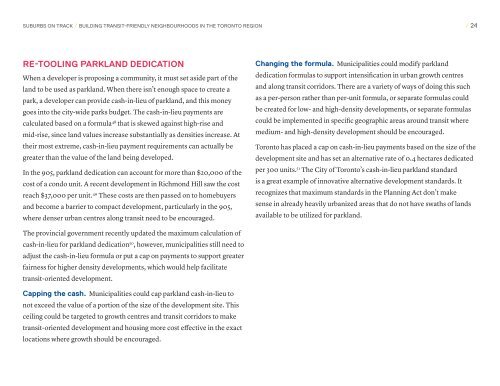SUBURBS ON TRACK
9oHn303Zgxi
9oHn303Zgxi
Create successful ePaper yourself
Turn your PDF publications into a flip-book with our unique Google optimized e-Paper software.
<strong>SUBURBS</strong> <strong>ON</strong> <strong>TRACK</strong> / BUILDING TRANSIT-FRIENDLY NEIGHBOURHOODS IN THE TOR<strong>ON</strong>TO REGI<strong>ON</strong> / 24<br />
RE-TOOLING PARKLAND DEDICATI<strong>ON</strong><br />
When a developer is proposing a community, it must set aside part of the<br />
land to be used as parkland. When there isn’t enough space to create a<br />
park, a developer can provide cash-in-lieu of parkland, and this money<br />
goes into the city-wide parks budget. The cash-in-lieu payments are<br />
calculated based on a formula 48 that is skewed against high-rise and<br />
mid-rise, since land values increase substantially as densities increase. At<br />
their most extreme, cash-in-lieu payment requirements can actually be<br />
greater than the value of the land being developed.<br />
In the 905, parkland dedication can account for more than $20,000 of the<br />
cost of a condo unit. A recent development in Richmond Hill saw the cost<br />
reach $37,000 per unit. 49 These costs are then passed on to homebuyers<br />
and become a barrier to compact development, particularly in the 905,<br />
where denser urban centres along transit need to be encouraged.<br />
Changing the formula. Municipalities could modify parkland<br />
dedication formulas to support intensification in urban growth centres<br />
and along transit corridors. There are a variety of ways of doing this such<br />
as a per-person rather than per-unit formula, or separate formulas could<br />
be created for low- and high-density developments, or separate formulas<br />
could be implemented in specific geographic areas around transit where<br />
medium- and high-density development should be encouraged.<br />
Toronto has placed a cap on cash-in-lieu payments based on the size of the<br />
development site and has set an alternative rate of 0.4 hectares dedicated<br />
per 300 units. 51 The City of Toronto’s cash-in-lieu parkland standard<br />
is a great example of innovative alternative development standards. It<br />
recognizes that maximum standards in the Planning Act don’t make<br />
sense in already heavily urbanized areas that do not have swaths of lands<br />
available to be utilized for parkland.<br />
The provincial government recently updated the maximum calculation of<br />
cash-in-lieu for parkland dedication 50 , however, municipalities still need to<br />
adjust the cash-in-lieu formula or put a cap on payments to support greater<br />
fairness for higher density developments, which would help facilitate<br />
transit-oriented development.<br />
Capping the cash. Municipalities could cap parkland cash-in-lieu to<br />
not exceed the value of a portion of the size of the development site. This<br />
ceiling could be targeted to growth centres and transit corridors to make<br />
transit-oriented development and housing more cost effective in the exact<br />
locations where growth should be encouraged.


